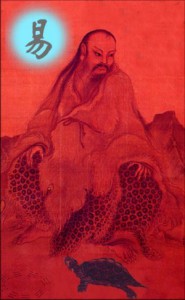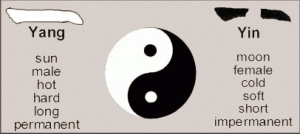What is The Yijing?
Definition: YIJING (I-CHING) = Classic of Change
Yijing, I Ching Before we begin let me say that it is beyond the scope of this web page to go into a detailed discussion of the Yijing (classic of change). I hope this short introduction will lead the student into a more detailed pursuit of the matter as explained in many of the fine books that are available in any bookstore.
The Yi is a book of wisdom and guidance. It is not a metaphysical or magical work although at times when used as an oracle the answers may seem like magic. The Yi is based on sound practical wisdom. You cannot use the Yi to gain mystical power over nature or other people. It was never intended to be a magical, satanic or religious work.
As we will see the Yijing opens up our minds and hearts to the flow of things as they are. It blows aside the dust of illusion, points to the appropriate path for each situation. You have the choice to learn from nature and participate in the situation or walk away. In the final analysis we choose our own fates, we make our own luck based upon the consequences of our personal choices as to how we harmonize with events surrounding us. The Yi just points out the path, successes and pitfalls that will most likely occur.
The Yijing, or Book of Changes, is one of the most ancient books in the world. It represents both the source of Chinese culture and a key to the understanding of Chinese history, medicine and philosophy. The Yijing concepts were developed in China’s pre-historical period. The Yijing reveals the great wisdom and understanding concerning nature and man that can be found when one begins to comprehend the stages of change that take place in every thing, person and situation found in nature.
The Chinese character for the word Yi is created by combining the symbols for the sun and the moon, and this combination presents the most fundamental perception of Chinese philosophy towards experience and life. Later this idea evolved into the symbols of Yin and Yang and became know as the Taiji, but before the symbol there was the idea of alternating polarity.
First, the sun and moon are alternating qualities that follow each other in a circular path. The sun rises and comes to its zenith, and begins to decline. It disappears below the horizon, and the moon appears. The sun follows the moon, and then the moon follows the sun again. Night follows day and the seasons follow each other in succession. First one dominates then the other. Together, the opposing qualities of the sun and moon create a complex and always changing series of influences on the life of our planet.
As we observe the interaction of their opposition, we come to another perception – their contrasts and the contrasts of similar energies here on earth are what make life possible. Thus we can say that the change from light to dark not only oppose each other, but also complement each other. The study of the Yijing evolved from this simple idea, to consider all the things that have physical reality and how humans’ experience, do, say, feel, and deal with life. The Yijing imparts the same lesson modern physics is beginning to reveal. That is without contrast, there is nothing. With it, anything in our world may be seen and described. Our world and life are based on the activity and changes of this polarity.
Difficult and easy complement each other.
Long and short are in contrast to each other.
High and low rest upon each other in mutual support.
Tone and pitch are in harmony with each other.
Front and back follow each other in succession.
Lao Zi – Daodejing.
Creator of the Yijing
 Chinese legend tells us that the concept of the Yijing came from the mind of the first Emperor, Fu Xi (2953-2838 BC). It is said that Fu Xi Fu Xiset out to study all of heaven and earth. Legend says that one-day while meditating by the river he saw on the back of an ancient tortoise a series of cracks. Some long and continuous and others broken and short. He had a vision and from this he drew two lines one long and straight and the other broken in the center.
Chinese legend tells us that the concept of the Yijing came from the mind of the first Emperor, Fu Xi (2953-2838 BC). It is said that Fu Xi Fu Xiset out to study all of heaven and earth. Legend says that one-day while meditating by the river he saw on the back of an ancient tortoise a series of cracks. Some long and continuous and others broken and short. He had a vision and from this he drew two lines one long and straight and the other broken in the center.
The long line he called yang and the broken line yin. Each line is called a Yao. We can think of these lines as a symbol for the expression of a type of energy. The first two Yao, Yang and Yin were the beginning of the Yijing and were later evolved into the trigrams, as we know them today.
With this idea of opposite energies Fu Xi turned his eyes to the heavens and studied astronomy as well as the movements of the sun, the stars, the moon, and the planets. He turned back to earth and observed the flat, the rolling, and the mountainous land, how some soil was good for tilling and other soil was not. He studied the weather, the tides, the storms, and the regular changes of the seasons. Natural history claimed his interest, and he watched the birds and the animals and deciphered their languages.
He found enlightenment through the very practical process of examining the concepts of space and time. By understanding time and the cycle of life, he found that he could explain all events based on cycles of change in his Yin and Yang concepts. He sought to find the explanation of change in a person, thing, or event. The constancy of cycles that repeat themselves faithfully makes possible all that we experience and do. These cycles always bring us change and the freedom to change, and at the same time create the unchanging foundation of our life and world.
Finally Fu Xi turned to observe and study within himself. Out of this he created the eight trigrams as a method to understand and make use of natural energies in the visible world and the energies of the invisible world. He also used it to represent the relationships of everything in our three dimensional world and to build images of anything in our world. Over time the Yijing evolved into an index or almanac of nature’s laws as they apply to the planets, stars and the affairs of all humans, plants and animals in the world.
Taiji and Yin and Yang
Shown here is an example of correspondence. The Yang and Yin are polar opposite energies that are also complementary. One cannot exist without the other to contracts against it. These are only a few of the examples. This list could contain thousands of words and still not completely cover all the opposing ideas, things and energies in the universe.
It is also important to note that I have placed a Taiji Du symbol in the center merely for illustration purposes. This symbol was created many years later in China as another expression of the concept of Yin and Yang interaction. We will learn more about this in the following section.

